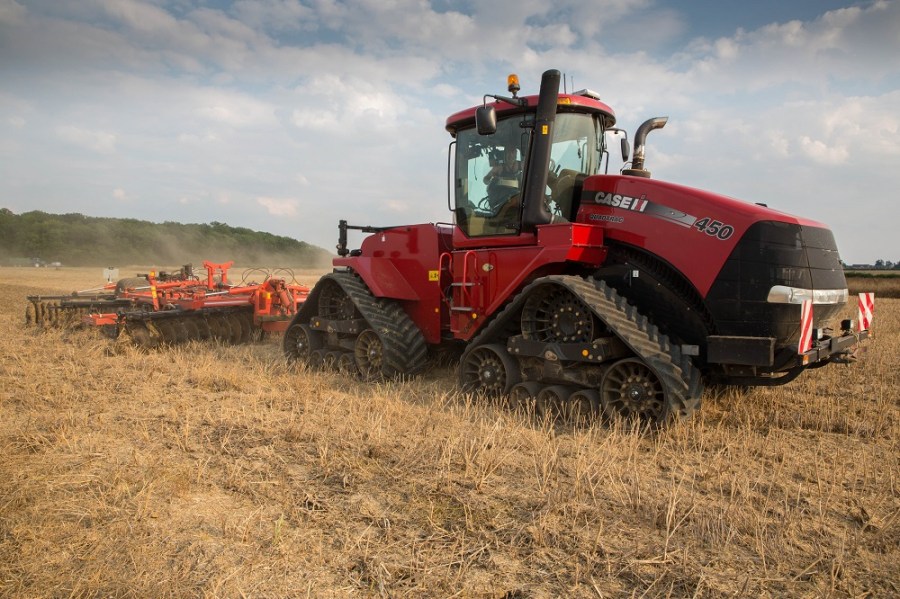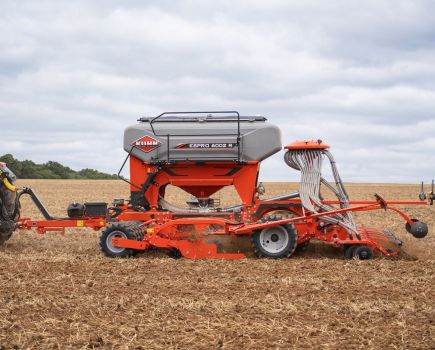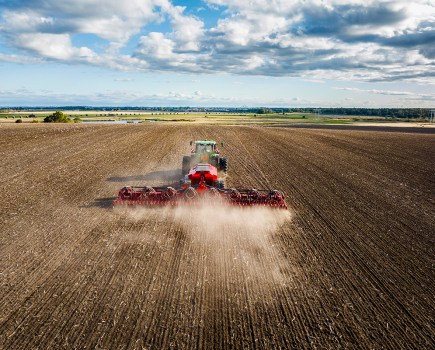The crushing weight of modern farm machinery means compaction is now a major factor affecting the health and productivity of agricultural land. CPM find outs what it’s actually doing to our soils and what can be done about it.
Machines can push the compaction problem to more than a metre deep, which is impossible to rectify mechanically.
By James Andrews
All farmers know that pummelling fields with heavy agricultural machinery is potentially bad news for soil structure, crop rooting and yields.
But less is known about the physical changes that this process initiates throughout the soil profile and the long-term effects this has on productivity.
To find out more we asked the experts what this heavy machinery is actually doing to soils and what can be done to fix it or prevent it occurring in the first place.
The problems
Prof Paul Hallett is a soil physicist at Aberdeen University and specialises in the physical, chemical and biological processes that take place in soils. We asked him what his recent work had revealed about the state of soil compaction on UK soils and the impact it’s having on crop performance.
How serious is soil compaction in the UK?
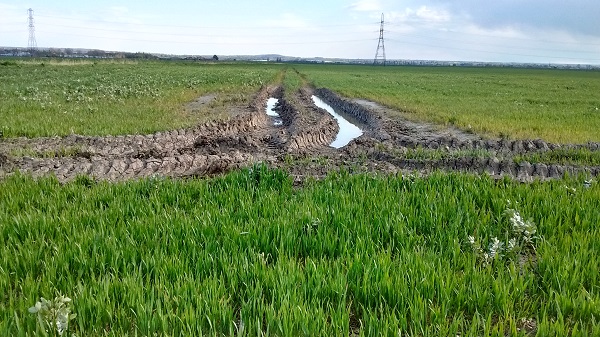
Try to use lighter machinery, avoid travelling when it’s wet and use the lowest possible tyre pressures or tracks.
A recent broad-scale project looked at the condition of 850 different soils across Scotland. Of these, 20% were identified as having structurally degraded topsoils and 10% had structurally degraded subsoils. It’s likely that this situation is repeated in a similar fashion throughout the UK.
Deeper-level compaction is also a concern due to the massive weight of some modern agricultural machinery. A few of these bits of kit breach the weight limit for driving on a motorway, so it’s no wonder that they cause serious damage to our soils.
Even if these machines are fitted with tracks or wide tyres at the correct pressures, they can still push the compaction problem to more than a metre deep, which is impossible to rectify mechanically.
Which soils are most susceptible?
Soils with a tighter structure and smaller pore sizes are the least susceptible to compaction.
That means clay soils are actually some of the best at carrying heavy machinery, providing conditions are good. Sandy loam soils or glacial silts are affected particularly badly as they have an open structure with lots of air pockets in between the particles that can be squashed by heavy machinery.
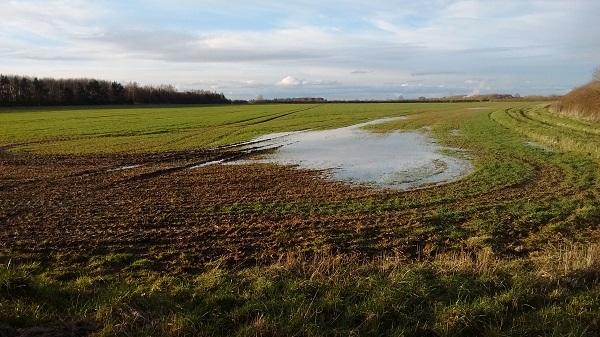
If there’s water sitting on the field this could be down to poor land drainage
Luckily, in the UK a large proportion of soils aren’t actually that susceptible to compaction when conditions are good. So if you have to take a 20t plus machine onto the field, try to only do so when the ground is dry.
Interestingly, a recent German study showed that the financial penalty of establishing a crop in poor conditions was greater than not planting one at all. This was due to the costs of having to rectify the soil damage afterwards.
What problems does it cause?
There are several. Firstly, it seriously affects root growth, causing plants to develop shallow, linear root structures.
In a dry year, this means they can be susceptible to drought stress as there are fewer roots penetrating into the damper subsoil to access water.
It also reduces the plant’s ability to pick up nutrients, particularly nitrogen. Often robust rates of artificial nitrogen mask this, but if applications were reduced you could start to see a yield penalty.
Another problem is that once the air is squeezed out of the soil structure it can become an anaerobic environment, which produces nitrites that are toxic to plants.
Are some crop varieties more susceptible?
It’s important to note that varieties that make it to the top of the AHDB Cereals and Oilseeds Recommended List aren’t necessarily the ones that’ll achieve the best yields in soils that are suffering compaction.
Generally trial crops are grown in ideal conditions with loose, open soils so they’ve never been tested in poorly structured soils.
At the moment the James Hutton Institute is running a study looking at the performance of different winter barley varieties in a range of soil conditions. This will be concluding in the autumn, so it’ll be interesting to see the findings.
How do you relieve compaction?
The best way to solve the compaction problem is to prevent it happening in the first place. That means trying to use lighter machinery, avoiding travelling when it’s wet and using the lowest possible tyre pressures or tracks.
However, it’s important to remember that low tyre pressures or tracks can lull people into a false sense of security as the compaction problem is often just being pushed deeper into the soil profile.
Many farmers think that running through the ground with a subsoiler will correct most compaction problems. However, studies suggest the benefits of subsoiling are relatively short lived as soils will soon slump back down, particularly if they’re driven on again with heavy machinery.
There’s also little economic gain for doing it unless you’re combining it with another job such as incorporating organic matter.
Targeted subsoiling – such as lifting tramlines or small areas where there’s a known problem – is a more worthwhile operation though.
If soils are given a rest from heavy traffic and deep cultivation then they’ll recover in time. That’s due to a combination of wetting and drying that causes natural fissures to develop and to give time for plants to send roots deep down into the soil profile.
Overall, the most cost-effective methods for relieving compaction were the ones that prevented it happening in the first place.
The solutions
Harry Henderson is AHDB’s Knowledge Exchange manager for the east of England and has had plenty of experience of the damage compaction can cause and best ways of dealing with it. We asked him for some practical pointers.
How do you spot compaction?
The first thing to find out is if you really do have compaction and not to just head out with the subsoiler and hope for the best.
If there’s water sitting on the field this could be down to poor land drainage, collapsed mole drains or compaction deep down in the soil profile that you can’t reach. It’s said time and time again, but you need to dig a hole and find out what and where the problem is.
Also, if you don’t get any definitive answers digging a shallow hole with a spade, it might be worth getting a mini digger in the field to see what’s going on deeper.
What about drainage?
Due to the high price of draining agricultural land, a lot of farms have suffered from underinvestment in this area. Unfortunately, a lot of the drains that were installed when there were grants available in the 1960s and 1970s were put in with little or no backfill so they can suffer from silting up, particularly when land has been intensively cultivated.
Wet conditions will intensify compaction and encourage the growth of blackgrass, so it’s an important problem to solve. Even though it can cost around £2500/ha to install proper land drains, it’s not actually that much when you consider the benefits over a 20-year period.
Getting drains inspected for blockages and jetting them can be a cheaper short-term fix as well as patching the worst affected areas.
What about machine weight?
One of the big problems with some of the more powerful tractors on the market is that they’re seriously heavy and there’s no way to shed any of that weight.
Take John Deere’s 9RX for example – that comes in at about 28t and there’s no way of removing any of that bulk, even if the job requires less weight or the conditions are too poor to take it.
It’s also worth considering if all that power and is being used to correct problems that have been caused by the weight of the tractor in the first place.
Ask yourself if a lighter machine with similar power could do the job. You then have the ability to add or remove ballast according to the conditions.
Massive self-propelled harvesters lifting late root crops are another concern, particularly for deep-level compaction as they can push the problem as much as 1.2-1.5m down into the soil profile. This can’t be corrected with a machine and time is the only cure.
Is wheel slip a concern?
Wheel slip is another big contributor to soil damage particularly in the top 5cm of soil.
If you can’t adjust tyre pressures sufficiently to get wheel slip under control, then you should really accept that conditions aren’t suitable for crop establishment. It’s far better to come back in the spring than maul a crop in and cause damage in the autumn.
Mounted or trailed?
Many farmers don’t think about this, but heavy linkage-mounted equipment is a serious contributor to compaction.
Not only does it put a huge load through the rear axle of the tractor onto the soil, but it also requires the addition of a massive counterweight.
Front linkage-mounted weights also hang a considerable distance in front of the tractor so a huge amount of force is exerted on the smaller front wheels, which is then transferred to the soil.
For those running the biggest linkage-mounted kit it might be worth considering switching to a trailed implement when an upgrade is next due as there’ll be an extra axle or two to help spread the weight.
Toolbar drills with front-mounted hoppers also help distribute weight across axles evenly and remove the need for a dead weight on the front.
Mounting some of the biggest mounted fertiliser spreaders on a wheeled bogie is also a sensible idea.
Does soil organic matter help?
Soils with a higher organic matter content are less susceptible to compaction, so any efforts to increase this will be beneficial. However, it’s a costly process and takes a lifelong commitment to make any significant improvements.
Farmyard manure is probably the most effective input for raising soil organic matter content in the short term. Sewage sludge also works well, but this is often applied by incredibly heavy self-propelled spreaders. If these run in less-than-ideal conditions, it can make the problem worse.
Does Controlled Traffic Farming help?
If you’re running big, heavy machinery then it’s a no brainer to confine these operations to as small an area of the field as possible. This may one day become standard practice, particularly for nutrient applications and harvesting operations.
That’s partly because these are the heaviest and most damaging machines, but also because it’s relatively straightforward to fit them into the system.
The benefits are less clear-cut for establishment operations though, as you often need a big, expensive drill and generally a large, heavy tractor to pull it.
So there are merits for having a narrower, lower-disturbance drill on a lower-powered, lighter tractor that doesn’t have to work to the same wheelings.
This also means that the ground can be drilled at an angle to the previous crop, which helps even up the field and reduce runoff risk.
Tyre tuning
Picking the correct tyres for a machine and getting them set at the optimum pressure is one of the easiest ways to reduce soil damage, particularly in the topsoil.
“The most important thing is to set the inflation pressure at the minimum amount for the load being carried,” says Kirk Walker of Mitas.
“This way the tyre will have the biggest possible footprint on the ground, spreading the weight over a larger area – like snow shoes – and as a result, compaction will be reduced.”
Increasing the tyre’s footprint also reduces wheel slip, which saves fuel and time in the field, he adds.
The latest tyre technology offers a 40% benefit over that of a standard tyre, points out Steve Lamb from Bridgestone, which potentially means a 40% decrease in tyre operating pressure.
“With this latest technology, you don’t always have to go wider, as in the past,” he adds. “And it’s very important to have the correct front and rear axle weight balance, to ensure that the available horsepower is distributed correctly to each square inch of the total contact patch.”
Most of the major tyre manufacturers now offer a smartphone or tablet app to help farmers make sure they’re running their tyres at the optimum pressure for the task in hand.
Firestone’s app was launched in 2011 and includes recommended running pressures for all of its agricultural tyres according to load.
All the tractor driver has to do is select the tyre model and size, before inputting the load that’ll be on each tyre. The app then gives a recommended pressure for a range of speeds.
Mitas has recently launched an app that works in a similar fashion. Both are available for Apple and Android devices.
Keeping tabs on organic matter
The free SOCiT (Soil Organic Carbon Information) app has been developed by The James Hutton Institute and allows any farmer in Scotland to get an estimate of soil organic matter just by taking a picture of their soil.
It works by using the phone’s GPS signal to record the user’s position within a photograph of the soil, which is then sent back to the James Hutton Institute’s servers.
Here a clever algorithm uses a combination of information already known about that area as well as detail in the photograph to come up with the prediction.
To take a sample, all the user needs to do is dig a small hole and take a picture with a colour correction card in the shot. These are available for free from the James Hutton Institute. The entire process takes around five minutes.
Matt Aitkenhead, scientist at the James Hutton Institute, developed the modelling system behind the app and says it gives a pretty accurate prediction of soil organic matter without the need for time-consuming and costly analysis.

